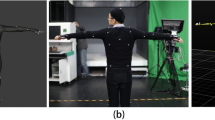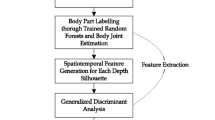Abstract
A human motion recognition method based on Kalman random forest algorithm model is proposed to improve the accuracy and efficiency of tracking algorithm aiming at the multi-degree-of-freedom problem of traditional human motion recognition and tracking. Firstly, a simple explicit manifold space model of human motion parameters is established. Reconstruction of three-dimensional image features for human motion requires accurate identification of human behavioral features. The human motion process is highly random, and the sudden change in motion amplitude causes a sudden change in the number of shape-based parameters in the three-dimensional feature. The compact low-dimensional model simplifies the difficulty of human motion parameters contour tracking; Secondly, Kalman random forest algorithm is used to estimate the global transformation of action and the different distance measures of body action in each sub-state by using action characteristics through boundary approximation and action sequence updating, so as to reduce the computational complexity of the algorithm; Finally, the single shape change and the dynamic action in motion are modeled, and the dynamic tracking of human motion is realized through the linear combination of human motion shape and style factor decomposition.





Similar content being viewed by others
References
Atrsaei A, Salarieh H, Alasty A (2016) Human arm motion tracking by orientation-based fusion of inertial sensors and Kinect using unscented Kalman filter.[J]. J Biomech Eng 138(9)
Cabras S, Castellanos ME, Staffetti E (2016) A random forest application to contact-state classification for robot programming by human demonstration[J]. Applied Stochastic Models in Business & Industry 32(2):209–227
Cheng X, Hao Q, Xie M (2016) A comprehensive motion estimation technique for the improvement of EIS methods based on the SURF algorithm and Kalman filter[J]. Sensors 16(4):486
Kang CW, Kim HJ, Chan GP (2016) A human motion tracking algorithm using adaptive EKF based on Markov chain[J]. IEEE Sensors J 16(24):1–1
Kuhner A, Schubert T, Cenciarini M, et al (2016) A probabilistic approach based on Random Forests to estimating similarity of human motion in the context of Parkinson's Disease[C]// IEEE/RSJ International Conference on Intelligent Robots & Systems
Kumpán P (2017) Separation of Gravitational Acceleration from Acceleration of Human Motion Using Quaternion Based Unscented Kalman Filter[C]// International Conference Mechatronics
Li N, Xu C, Guo H et al (2016) Recognizing human interactions by genetic algorithm-based random forest spatio-temporal correlation[J]. Pattern Analysis & Applications 19(1):267–282
Olivares A, Gãrriz JM, Ramarez J et al (2016) Using frequency analysis to improve the precision of human body posture algorithms based on Kalman filters[J]. Computers in biology & Medicine 72:229–238
Author information
Authors and Affiliations
Corresponding author
Additional information
Publisher’s note
Springer Nature remains neutral with regard to jurisdictional claims in published maps and institutional affiliations.
Rights and permissions
About this article
Cite this article
Yi-Jie, Z., Chang-An, D. Human motion recognition based on Kalman random Forest algorithm and 3D multimedia. Multimed Tools Appl 79, 9891–9899 (2020). https://doi.org/10.1007/s11042-019-08018-w
Received:
Revised:
Accepted:
Published:
Issue Date:
DOI: https://doi.org/10.1007/s11042-019-08018-w




